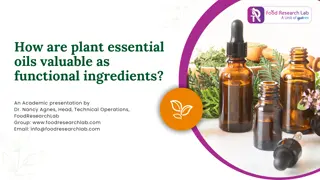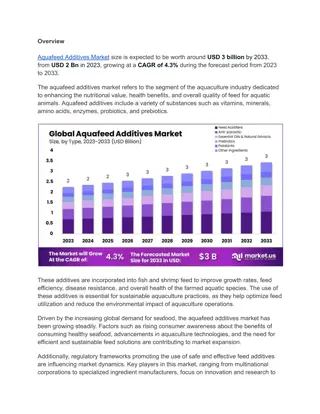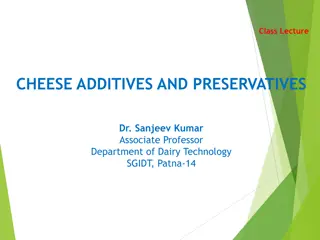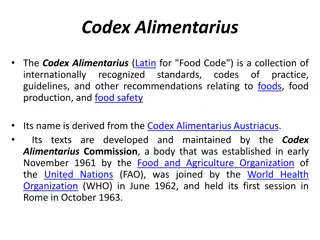Understanding Food Additives and Preservatives: A Comprehensive Overview
Substances added to food for safety, freshness, taste, or appearance are known as food additives. They play a crucial role in food production by maintaining quality and stability. Learn about natural and artificial preservatives, color additives, and their significance in the food industry.
Download Presentation

Please find below an Image/Link to download the presentation.
The content on the website is provided AS IS for your information and personal use only. It may not be sold, licensed, or shared on other websites without obtaining consent from the author. Download presentation by click this link. If you encounter any issues during the download, it is possible that the publisher has removed the file from their server.
E N D
Presentation Transcript
Substances that are added to food to maintain or improve the safety, freshness, taste, texture, or appearance of food are known as food additives. Some food additives have been in use for centuries for preservation such as salt (in meats such as bacon or dried fish), sugar (in marmalade), or sulfur dioxide (in wine). Many different food additives have been developed over time to meet the needs of food production, as making food on a large scale is very different from making them on a small scale at home. Additives are needed to ensure processed food remains safe and in good condition throughout its journey from factories or industrial kitchens, during transportation to warehouses and shops, and finally to consumers. The use of food additives is only justified when their use has a technological need, does not mislead consumers, and serves a well-defined technological function, such as to preserve the nutritional quality of the food or enhance the stability of the food.
The term preservatives refers to the functional name for a wide variety of compounds that help slow or prevent bacterial growth in a wide range of products, including foods, medicines, and personal care products. These compounds can be natural or synthetic
NATURAL PRESERVATIVES Natural preservatives are ingredients that are found in nature and can without artificial processing or synthesis with other substances prevent products from prematurely spoiling. These substances can be safe, effective alternatives to controversial synthetic preservatives such as parabens.
ARTIFICIAL PREVERVATIVES Artificial preservatives are a group of chemical substances added to food, sprayed on the outside of food, or added to certain medications to retard spoilage, discoloration, or contamination by bacteria and other disease organisms. Most preservatives are categorized by the federal government as food additives, which are defined by the Federal Food, Drug, and Cosmetic Act (FD&C) of 1938 as any substance, the intended use of which results directly or indirectly, in its becoming a component or otherwise affecting the characteristics of food. A subcategory of food preservatives are classified as generally r
COLOUR AS FOOD ADDITIVES Color additives, including food dyes and pigments, are substances derived from both synthetic and plant, animal or mineral sources that add color to food. The objective is to enhance natural colors, add color to otherwise colorless foods, compensate for natural color variations and help identify flavors (such as yellow for lemon).
NATURAL COLORS Natural Food Color is any dye, pigment or any other substance obtained from vegetable, animal, mineral, or source capable of coloring food drug, cosmetic or any part of human body, colors come from variety of sources such as seeds, fruits, vegetables, herbs, spices, minerals, algae & insect. According to the application a suitable Natural Color can be achieved by keeping in mind the factors such as PH. heat, light storage and the other ingredients of the formula or recipe. The storage ...
ARTIFICIAL COLOUR Artificial colours consist of water soluble synthetic dyes or the aluminum salts of these dyes, called Lakes. These seven synthetic dyes and their salts are deemed acceptable by most Food authorities for use in food. Blending the seven produces a wide spectrum of colour, including purple, black, brown, and variations of the primary colours.
FLAVOURING AGENT A flavour additive is a single chemical or blend of chemicals of natural or synthetic origin that provides all or part of the flavour impact of a particular food. These chemicals are added in order to replace flavour lost in processing and to develop new products. Flavourings are the largest group of food additives, with more than 1,200
NATURAL FLAVOURING AGENT Natural flavors, like artificial flavors, are food additives, the main function of which is to add flavor to food. Think of a banana-flavored baked good that doesn't actually have banana listed in the ingredients. Or an almond latte without actual almonds. What gives these foods their flavors and aromas? You guessed it natural and artificial flavors
SYNTHETIC FLAVOUR The synthetic fruit flavor market is expected to witness market growth at a rate of 6.40% in the forecast period of 2021 to 2028 and is expected to reach USD 7.69 billion by 2028. Data Bridge Market Research report on synthetic fruit flavor market provides analysis and insights regarding the various factors expected to be prevalent throughout the forecast period while providing their impacts on the market s growth. The rise in the food and beverage sector is escalating the growth of synthetic fruit flavor market. Food flavors refer to food additives that are utilized to improve the taste of food products and are usually availab
ARTIFICIAL SWEETNER Artificial sweetener is the most attractive substitute for sugar because it does not add more calories to our diet. This can be used directly in processed food like dairy products, puddings, candy, baked goods, jams, soft drinks, and other various foods and beverages. We can also use it after mixing with starch- based sweeteners.
ANTIOXIDANT Antioxidants are man-made or natural substances that may prevent or delay some types of cell damage. Diets high in vegetables and fruits, which are good sources of antioxidants, have been found to be healthy; however, research has not shown antioxidant supplements to be beneficial in preventing diseases. Antioxidant - Wikipedia
FLOUR IMPROVER Flour Bleaching Agents and Bread Improvers Oxidizing agents that function primarily as dough improvers Added to flour (10-40 ppm) at the mill Often incorporated into a dough conditioner mix then added at the bakery Potassium bromate Oxidizing agent and Dough improver Unreactive until yeast fermentation lowers pH of the dough and sufficiently to activate it Causes increased loaf volume, improved loaf symmetry and improved crumb and texture characteristics
Type of food additives preservatives Flavouring agent Sweetners Stabilisers antioxidant flour Improvers colour























